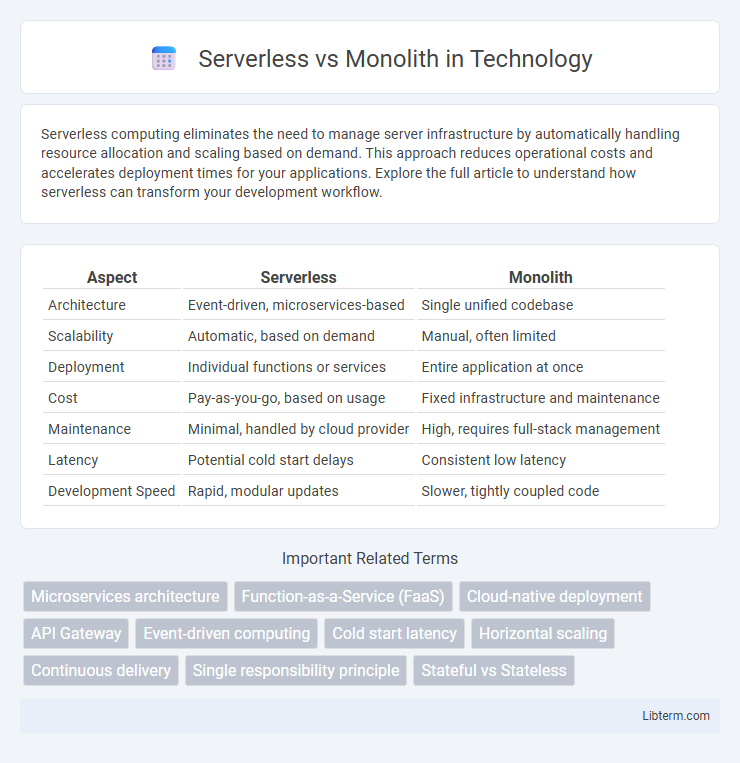Serverless computing eliminates the need to manage server infrastructure by automatically handling resource allocation and scaling based on demand. This approach reduces operational costs and accelerates deployment times for your applications. Explore the full article to understand how serverless can transform your development workflow.
Table of Comparison
| Aspect | Serverless | Monolith |
|---|---|---|
| Architecture | Event-driven, microservices-based | Single unified codebase |
| Scalability | Automatic, based on demand | Manual, often limited |
| Deployment | Individual functions or services | Entire application at once |
| Cost | Pay-as-you-go, based on usage | Fixed infrastructure and maintenance |
| Maintenance | Minimal, handled by cloud provider | High, requires full-stack management |
| Latency | Potential cold start delays | Consistent low latency |
| Development Speed | Rapid, modular updates | Slower, tightly coupled code |
Introduction to Serverless and Monolith Architectures
Serverless architecture allows developers to build and run applications without managing servers, enabling automatic scaling and cost-efficiency by executing code on demand through cloud providers like AWS Lambda or Azure Functions. Monolith architecture consolidates all application components into a single, unified codebase, simplifying development and deployment but often leading to challenges in scalability and maintenance. Understanding these fundamental differences helps organizations choose appropriate strategies for application design based on their operational requirements and growth expectations.
Core Principles of Serverless Computing
Serverless computing operates on the core principles of event-driven execution, automatic scaling, and abstracted infrastructure management, allowing developers to focus on code without managing servers. Unlike monolithic architectures that bundle all components into a single deployable unit, serverless promotes microservices and function-as-a-service (FaaS) to provide granular, independently scalable functionalities. This leads to reduced operational overhead, optimized resource utilization, and seamless handling of varying workloads.
Key Features of Monolithic Architecture
Monolithic architecture consolidates all components and functionalities of an application into a single codebase and deployment unit, ensuring tight integration and consistent performance. This architecture simplifies debugging and testing by centralizing the application logic, leveraging shared memory and resources for efficient data management. Scalability often involves replicating the entire application, which can limit flexibility but enhances straightforward deployment and maintenance workflows.
Scalability: Serverless vs Monolith
Serverless architecture offers automatic scalability by dynamically adjusting resources based on traffic, eliminating the need for manual intervention common in monolithic systems. Monolithic applications typically require significant infrastructure upgrades to handle increased load, often leading to performance bottlenecks. Cloud providers like AWS Lambda and Azure Functions provide fine-grained, event-driven scaling that supports rapid growth more efficiently than traditional monolithic scaling models.
Deployment and Maintenance Differences
Serverless architecture enables rapid deployment through automated scaling and event-driven functions, eliminating the need for server management and reducing maintenance overhead. Monolithic applications require deploying the entire codebase as a single unit, which can lead to longer deployment cycles and complex maintenance due to tight coupling of components. The modular nature of serverless significantly simplifies updates and patches by isolating functions, whereas monolithic systems often demand redeployment of the whole application even for minor changes.
Cost Considerations: Serverless vs Monolith
Serverless architecture minimizes upfront infrastructure costs by leveraging pay-as-you-go billing models, which directly scale with actual usage, reducing idle resource expenses commonly seen in monolithic setups. Monolithic architectures often incur higher fixed costs due to dedicated servers or virtual machines running continuously regardless of demand fluctuations. Cost efficiency in serverless solutions is particularly advantageous for applications with unpredictable workloads, while monoliths may yield lower expenses in consistently high-load environments.
Security Implications in Both Architectures
Serverless architectures reduce attack surfaces by abstracting infrastructure management and automatically patching security vulnerabilities, but they require robust function-level access controls to prevent privilege escalation. Monolithic systems consolidate code and data within a single environment, which simplifies perimeter defense but increases risk if a breach occurs, potentially exposing the entire application. Both models demand rigorous identity and access management (IAM) policies, encryption standards, and continuous monitoring to mitigate threats effectively.
Performance and Latency Comparison
Serverless architectures offer scalable performance by dynamically allocating resources based on demand, reducing cold start latency through optimized container reuse, whereas monolithic applications typically provide consistent low-latency response times due to in-memory processing within a single deployment unit. Serverless functions may experience increased latency during cold starts or network communication between distributed services, impacting performance unpredictably under heavy load. Monolithic systems benefit from reduced inter-process communication overhead but can face scalability bottlenecks affecting overall throughput and latency under high concurrency.
Use Cases: When to Choose Serverless or Monolith
Serverless architecture excels in event-driven applications, rapid scaling requirements, and unpredictable workloads, making it ideal for startups, IoT solutions, and microservices-based projects. Monolithic architectures are better suited for tightly integrated systems with consistent workloads, such as enterprise resource planning (ERP) software and legacy applications. Developers should choose serverless for agility and cost-efficiency in variable-use scenarios, while monoliths fit well when performance and simplicity in deployment are priorities.
Future Trends in Application Architecture
Future trends in application architecture emphasize the growing adoption of serverless computing due to its scalability, cost-efficiency, and reduced operational complexity. Monolithic architectures are increasingly being decomposed into microservices or serverless functions to enhance agility and speed of deployment. Cloud providers intensify investments in serverless platforms, driving innovations that integrate AI, event-driven models, and fine-grained resource management, shaping the next evolution of cloud-native applications.
Serverless Infographic

 libterm.com
libterm.com